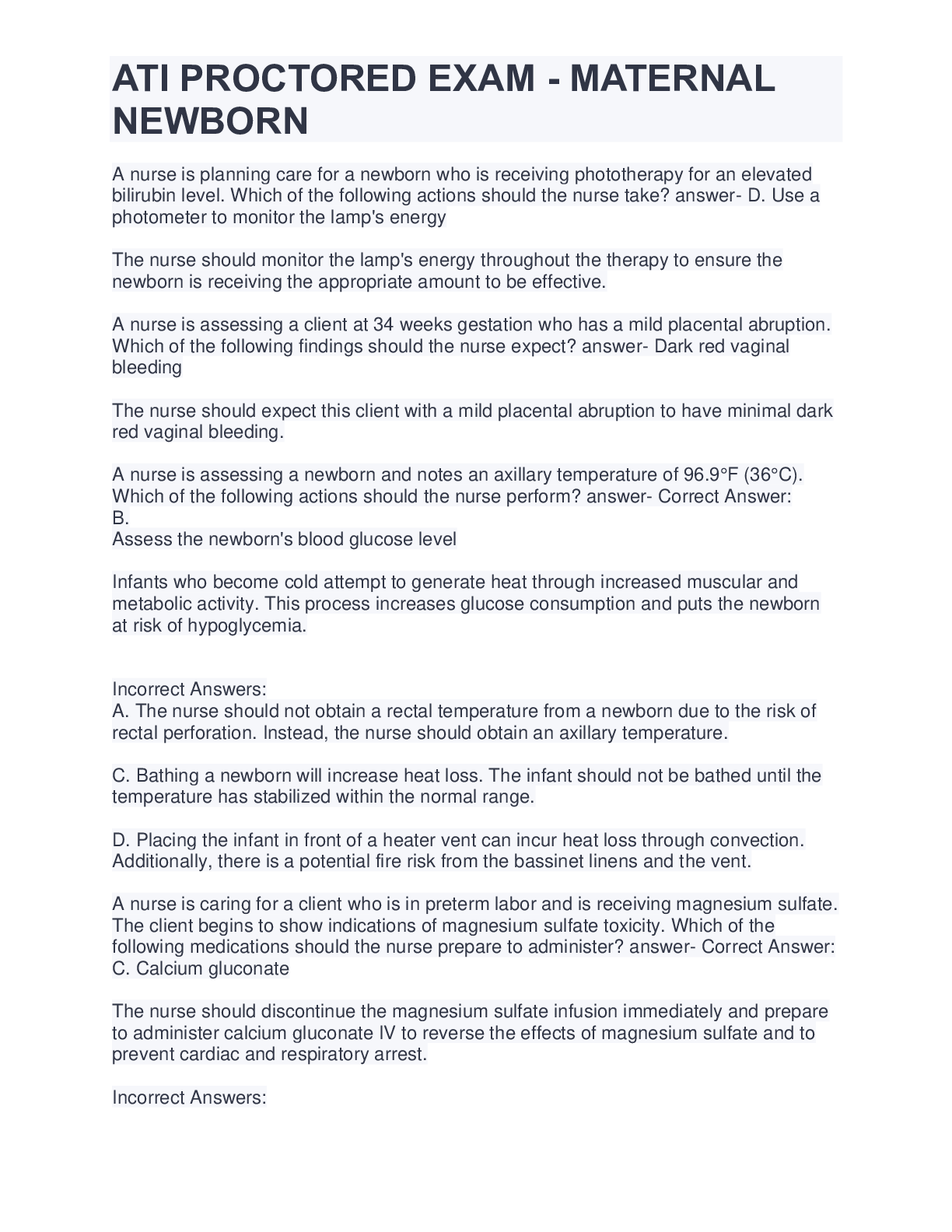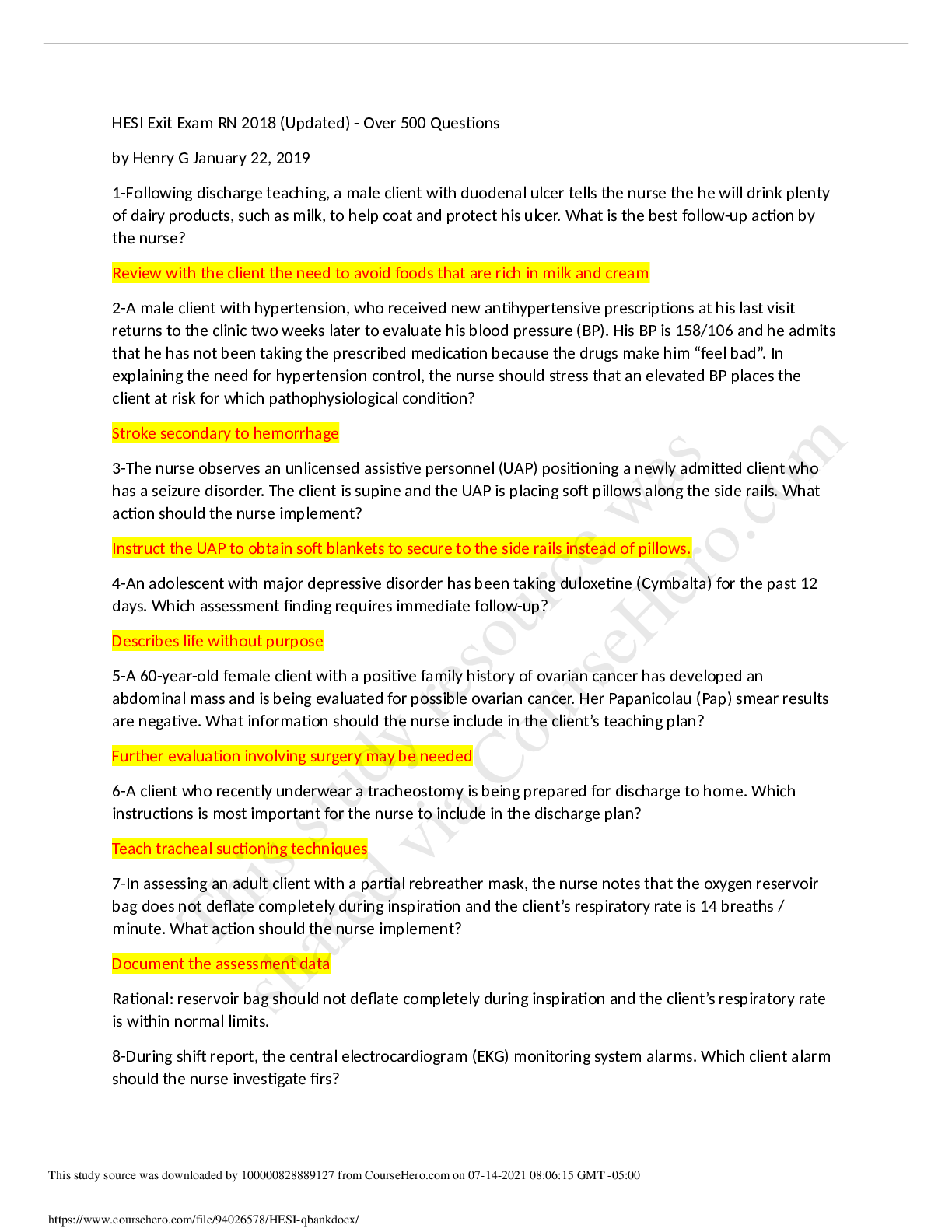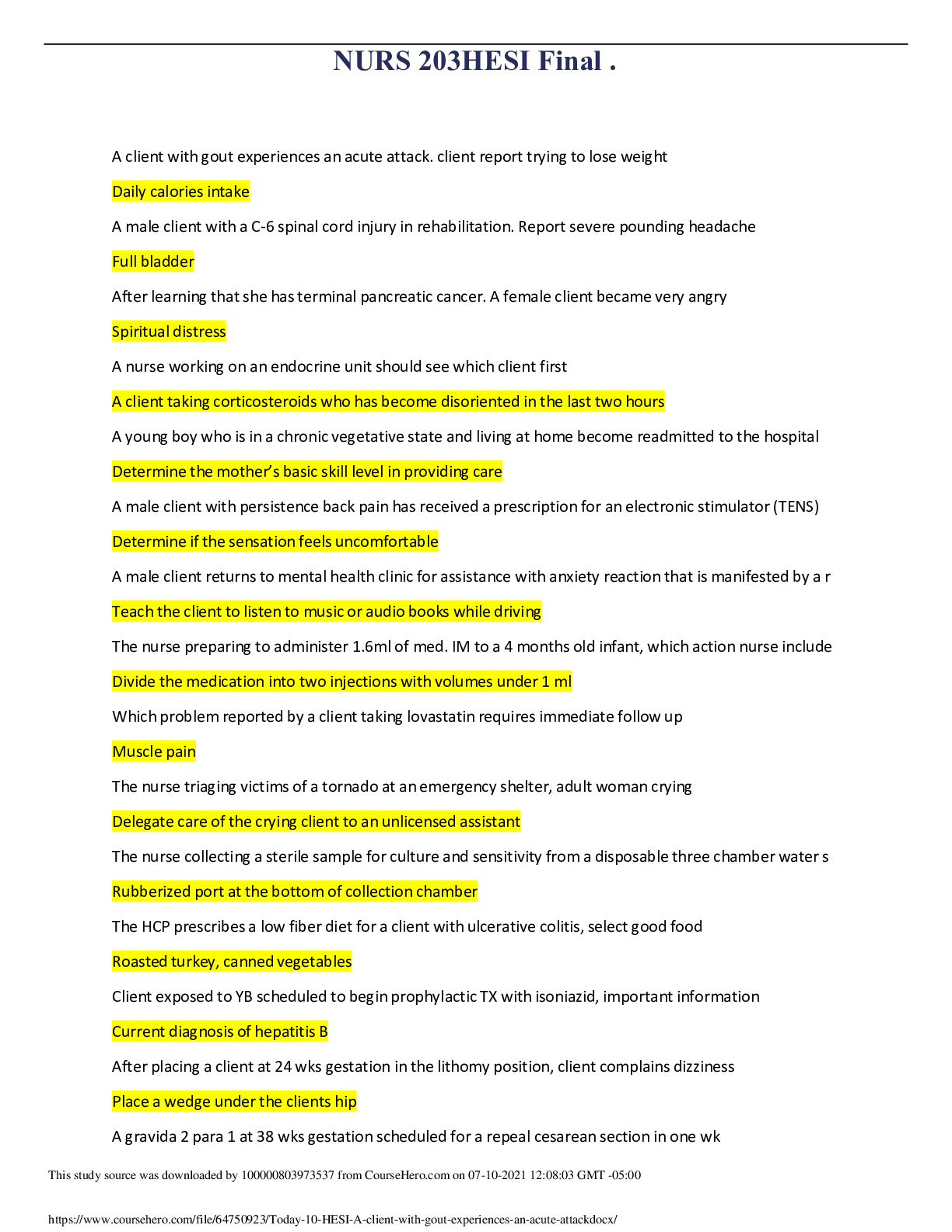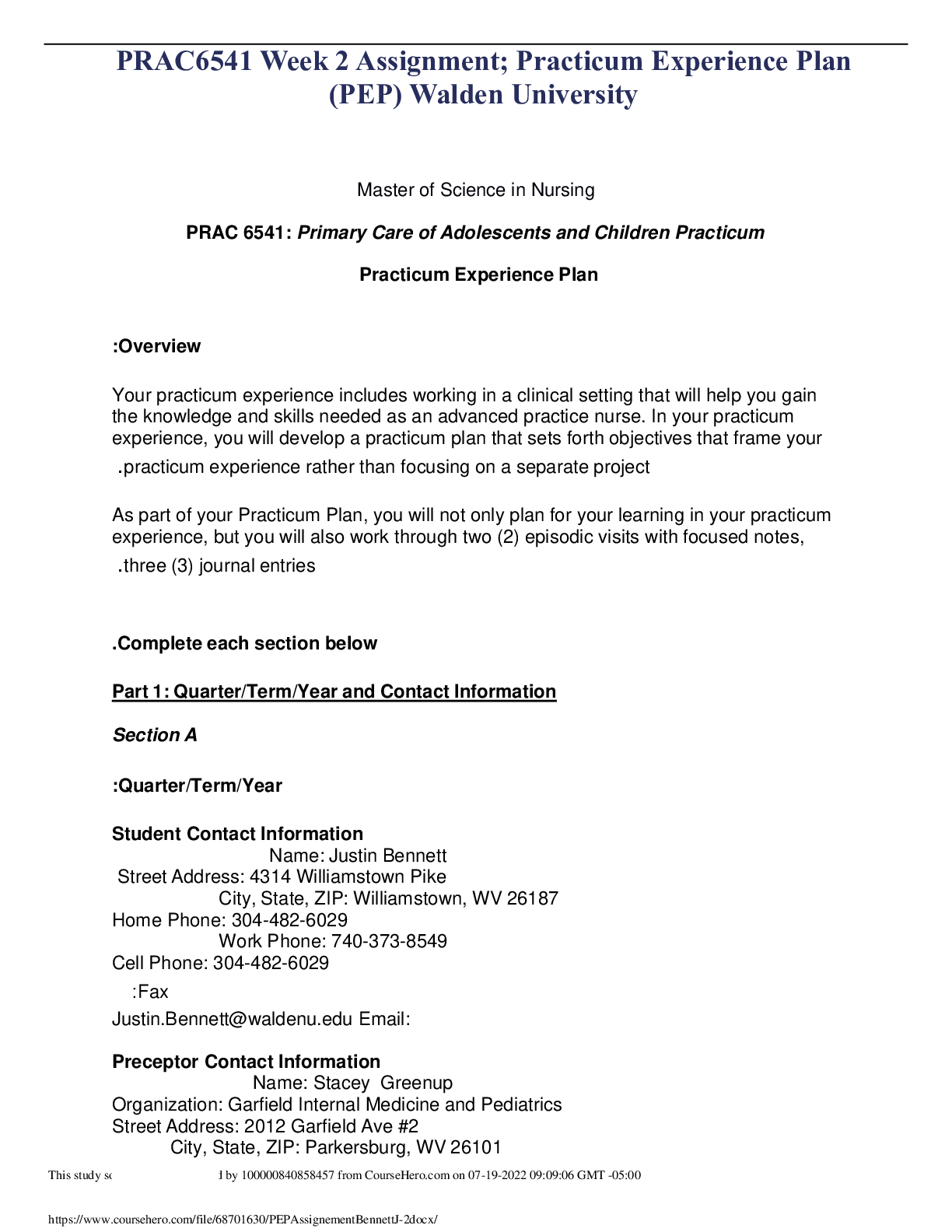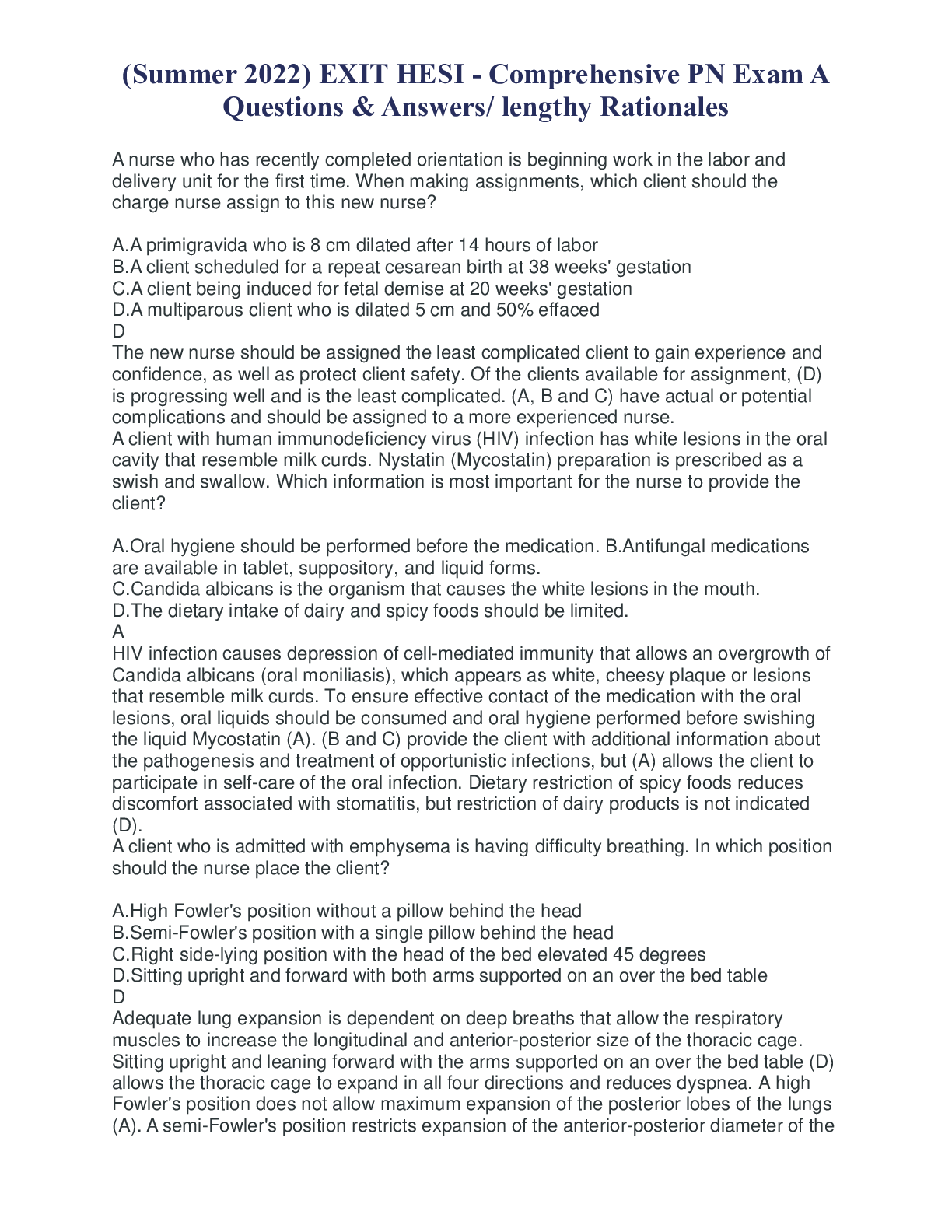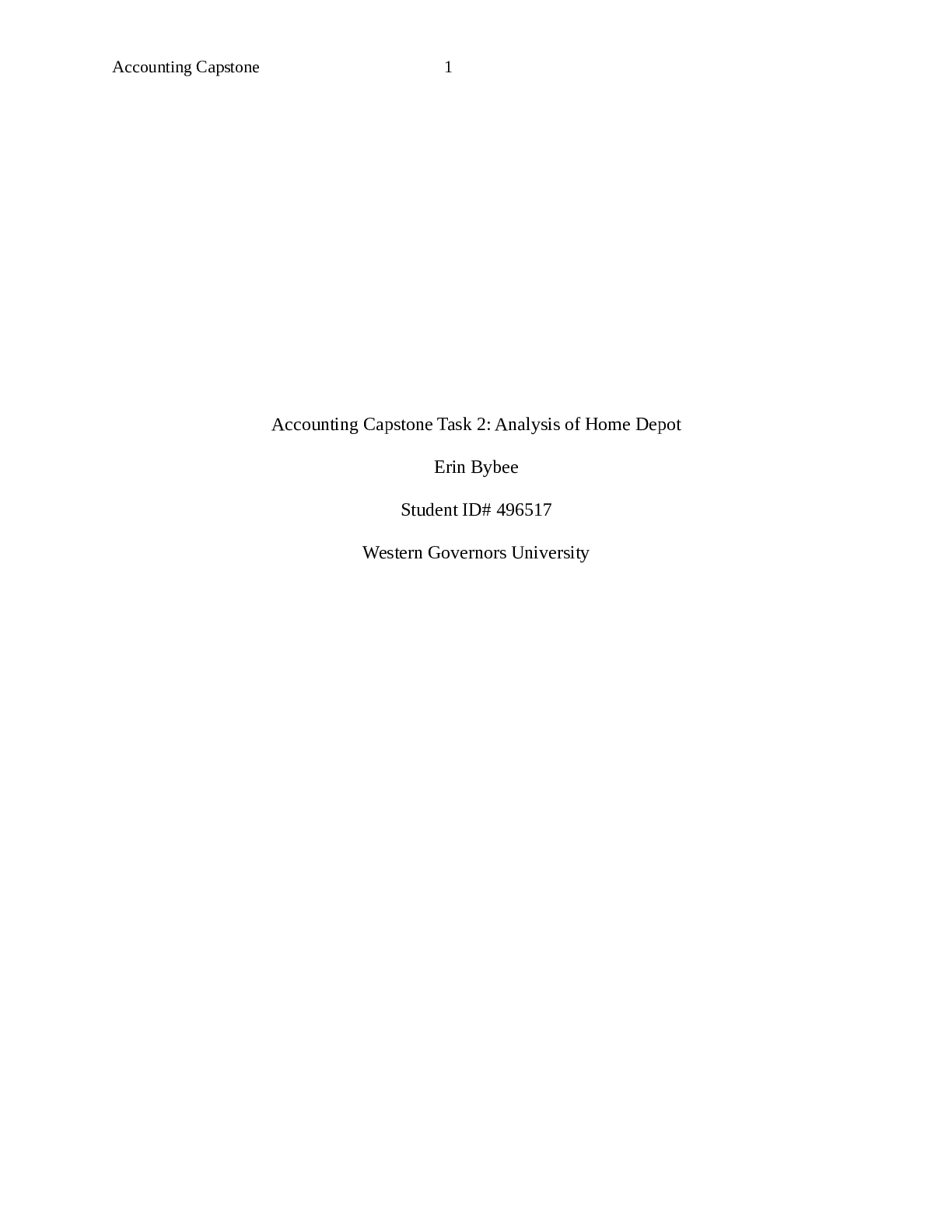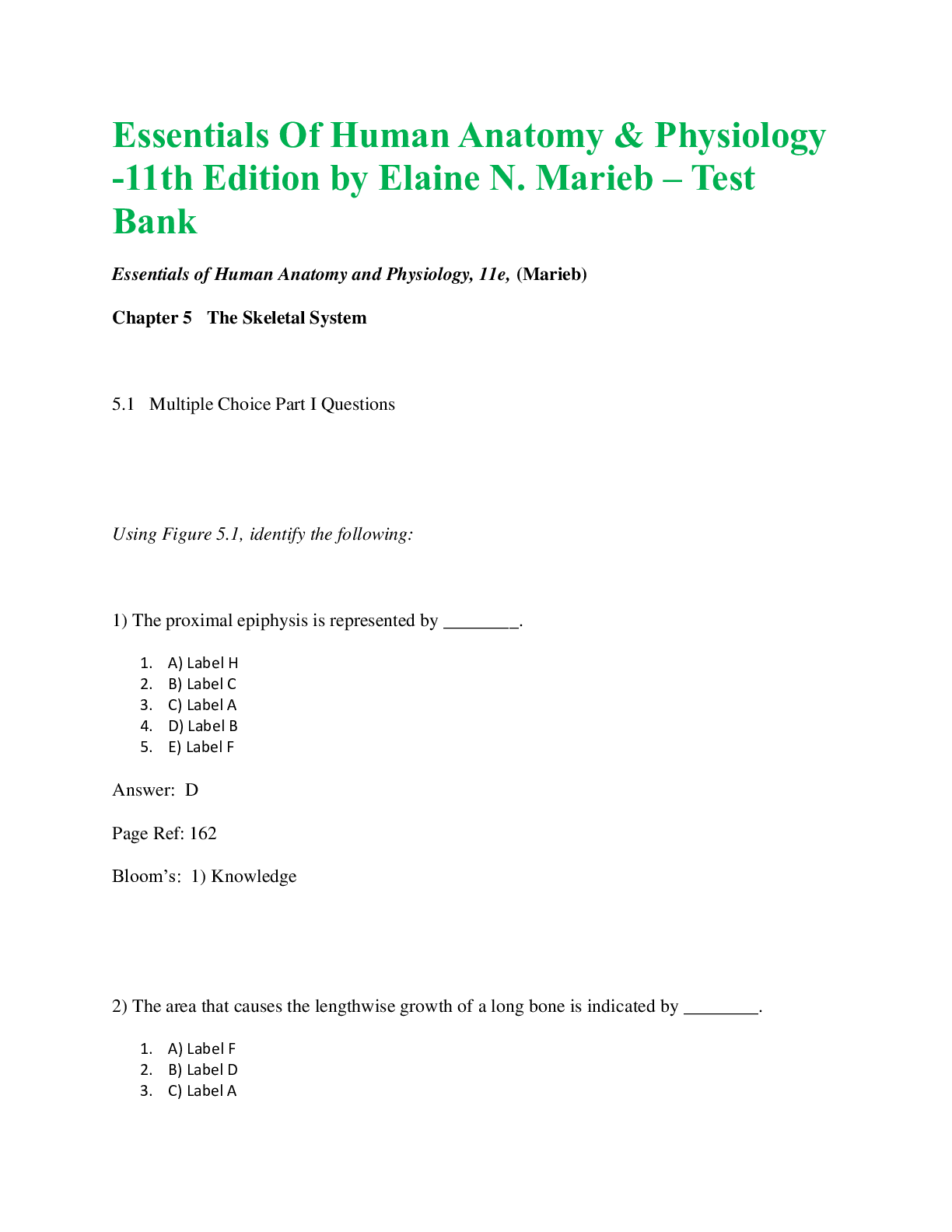*NURSING > EXAM > Biological Psychology 11th Edition by James W. Kalat complete Test Bank / Test Bank Biological Psych (All)
Biological Psychology 11th Edition by James W. Kalat complete Test Bank / Test Bank Biological Psychology 11e by James W. Kalat
Document Content and Description Below
Biological Psychology 11th Edition Test Bank by James W. Kalat Chapter 1: The Major Issues TRUE/FALSE 1. Neuroscientists are more interested in studying behavior than biological psychologists. ANS: F ... OBJ: 1 PTS: 1 DIF: factual REF: Introduction TOP: 1.1 The Biological Approach to Behavior 2. According to Tinbergen, a physiological explanation describes why a structure or behavior evolved as it did. ANS: F OBJ: 1 PTS: 1 DIF: factual REF: Introduction TOP: 1.1 The Biological Approach to Behavior 3. An evolutionary explanation describes why a structure or behavior evolved. ANS: F of Behavior MSC: www PTS: 1 OBJ: 1 DIF: factual REF: Biological Explanations TOP: 1.1 The Biological Approach to Behavior 4. An ontogenetic explanation is one that describes the development of a structure or behavior. ANS: T of Behavior MSC: www PTS: 1 OBJ: 1 DIF: factual REF: Biological Explanations TOP: 1.1 The Biological Approach to Behavior 5. A functional explanation describes why a structure or behavior evolved as it did. ANS: T of Behavior PTS: 1 OBJ: 1 DIF: factual REF: Biological Explanations TOP: 1.1 The Biological Approach to Behavior 6. Genes are the units of heredity. ANS: T OBJ: 5 PTS: 1 DIF: factual TOP: 1.2 Genetics and Behavior REF: Mendelian Genetics 7. A strand of DNA serves as a template (model) for the synthesis of RNA molecules. ANS: T OBJ: 5 PTS: 1 DIF: factual TOP: 1.2 Genetics and Behavior REF: Mendelian Genetics 8. It is possible for two heterozygous brown-eyed parents to have blue-eyed children. ANS: T OBJ: 5 1 PTS: 1 DIF: factual TOP: 1.2 Genetics and Behavior The Major Issues REF: Mendelian Genetics 9. If both parents are heterozygous, then all of their children should be homozygous. ANS: F OBJ: 5 PTS: 1 DIF: conceptual TOP: 1.2 Genetics and Behavior REF: Mendelian Genetics 10. The sex chromosomes X and Y are known as autosomal genes. ANS: F OBJ: 5 PTS: 1 DIF: factual TOP: 1.2 Genetics and Behavior REF: Mendelian Genetics 11. Sex-linked genes are usually found on the Y chromosome. ANS: F OBJ: 5 PTS: 1 DIF: factual TOP: 1.2 Genetics and Behavior REF: Mendelian Genetics 12. When chromosomes cross over, it is more likely to affect genes that are on separate chromosomes than genes that are on the same chromosome. ANS: T OBJ: 5 PTS: 1 DIF: factual TOP: 1.2 Genetics and Behavior REF: Mendelian Genetics 13. The genetic sex of an offspring is determined primarily by the sex chromosome contributed by the mother. ANS: F OBJ: 5 PTS: 1 DIF: factual TOP: 1.2 Genetics and Behavior REF: Mendelian Genetics 14. Sex-limited genes are found only on the X and Y chromosome. ANS: F OBJ: 5 PTS: 1 DIF: factual TOP: 1.2 Genetics and Behavior REF: Mendelian Genetics 15. To determine the contributions of heredity and environment, researchers rely mainly on studies of monozygotic and dizygotic twins. ANS: T Environment PTS: 1 OBJ: 4 DIF: factual REF: Heredity and TOP: 1.2 Genetics and Behavior 16. Researchers have found specific genes linked to certain specific behaviors. ANS: T Environment KEY: NEW PTS: 1 OBJ: 4 DIF: factual REF: Heredity and TOP: 1.2 Genetics and Behavior 17. The damaging effects of phenylalanine in children with PKU are unavoidable. ANS: F Environment 2 PTS: 1 OBJ: 4 DIF: factual REF: Heredity and TOP: 1.2 Genetics and Behavior Chapter 1 18. Genes become more prevalent in a population if they contribute to reproductive success. ANS: T Behavior PTS: 1 OBJ: 3 DIF: factual REF: The Evolution of TOP: 1.2 Genetics and Behavior 19. Humans have stopped evolving. ANS: F Behavior PTS: 1 OBJ: 5 DIF: conceptual REF: The Evolution of TOP: 1.2 Genetics and Behavior 20. Evolutionary psychology deals with how behaviors have evolved, especially social behaviors. ANS: T Behavior PTS: 1 OBJ: 5 DIF: factual REF: The Evolution of TOP: 1.2 Genetics and Behavior 21. Research scientists are free to do as they wish when conducting research with animals. ANS: F Research PTS: 1 OBJ: 4 DIF: factual REF: Reasons for Animal TOP: 1.3 The Use of Animals in Research 22. The underlying mechanisms of behavior are similar across species. ANS: T Research KEY: NEW PTS: 1 OBJ: 4 DIF: factual REF: Reasons for Animal TOP: 1.3 The Use of Animals in Research 23. Invertebrate nerves follow the same basic principles as human nerves. ANS: T Research KEY: NEW PTS: 1 OBJ: 4 DIF: factual REF: Reasons for Animal TOP: 1.3 The Use of Animals in Research 24. Minimalists do not tolerate any kind of animal research. ANS: F Research KEY: NEW PTS: 1 OBJ: 2 DIF: factual REF: Reasons for Animal TOP: 1.3 The Use of Animals in Research 25. Professional organizations such as the Society for Neuroscience publish guidelines for the use of animals in research. ANS: T Research KEY: NEW PTS: 1 OBJ: 3 DIF: factual REF: Reasons for Animal TOP: 1.3 The Use of Animals in Research 26. Abolitionists maintain that no animals have the same rights as humans. ANS: F Research KEY: NEW 3 PTS: 1 OBJ: 4 DIF: conceptual REF: Reasons for Animal TOP: 1.3 The Use of Animals in Research The Major Issues 27. The dispute between abolitionists and animal researchers is a dispute between two ethical positions. ANS: T Research KEY: NEW PTS: 1 OBJ: 2 DIF: factual REF: Reasons for Animal TOP: 1.3 The Use of Animals in Research 28. The ethical debate between animal researchers and abolitionists has always proceeded in an intelligent and mutually respectful way. ANS: F Research KEY: NEW PTS: 1 OBJ: 5 DIF: factual REF: Reasons for Animal TOP: 1.3 The Use of Animals in Research MULTIPLE CHOICE 1. Biological psychologists are primarily interested in the study of the physiological, evolutionary, and ____. a. social influence on attitudes b. developmental mechanisms of behavior and experience c. use of reinforcement to change behavior d. mental well-being of plants ANS: B OBJ: 4 KEY: NEW PTS: 1 DIF: factual REF: Introduction TOP: 1.1 The Biological Approach to Behavior 2. At the microscopic level, we find two kinds of cells: ____. a. molecules and mitochondria b. mitochondria and glia c. neurons and glia d. neurons and molecules ANS: C OBJ: 4 KEY: NEW PTS: 1 DIF: factual REF: Introduction TOP: 1.1 The Biological Approach to Behavior 3. The primary difference between biological psychologists and neuroscientists is that neuroscientists place greater emphasis on studying: a. chemistry. b. psychology. c. biology. d. behavior. ANS: D of Behavior KEY: NEW 4 PTS: 1 OBJ: 4 DIF: factual REF: Biological Explanations TOP: 1.1 The Biological Approach to Behavior Chapter 1 4. Much of biological psychology concerns: a. chemistry. b. brain functioning. c. neurology. d. anatomy. ANS: B of Behavior KEY: NEW PTS: 1 OBJ: 4 DIF: factual REF: Biological Explanations TOP: 1.1 The Biological Approach to Behavior 5. Jill is interested in studying how hormones influence sexual behavior of rats. She is most likely a: a. biological psychologist. b. neuroscientist. c. clinical psychologist. d. psychiatrist. ANS: A of Behavior KEY: NEW PTS: 1 OBJ: 4 DIF: conceptual REF: Biological Explanations TOP: 1.1 The Biological Approach to Behavior 6. The question “Given this universe composed of matter and energy, why is there such a thing as consciousness?” is called the ____. a. cosmic force question b. mind-body problem c. universal question d. biological problem ANS: B OBJ: 4 PTS: 1 DIF: conceptual REF: Introduction TOP: 1.1 The Biological Approach to Behavior KEY: NEW 7. A fundamental property is one that ____. a. answers all questions b. occurs only in certain parts of the nervous system c. cannot be reduced to something else d. cannot be explained ANS: C OBJ: 4 PTS: 1 DIF: conceptual REF: Introduction TOP: 1.1 The Biological Approach to Behavior KEY: NEW 8. If a person believes that hormones released at different stages of the menstrual cycle affect a person’s mood, then it would be considered a(n) ____ explanation. a. functional b. ontogenetic c. physiological d. evolutionary ANS: C of Behavior KEY: NEW 5 PTS: 1 OBJ: 1 DIF: conceptual REF: Biological Explanations TOP: 1.1 The Biological Approach to Behavior The Major Issues 9. A(n) ____ explanation describes why a structure or behavior evolved as it did. a. functional b. ontogenetic c. physiological d. evolutionary ANS: A of Behavior KEY: NEW PTS: 1 OBJ: 1 DIF: conceptual REF: Biological Explanations TOP: 1.1 The Biological Approach to Behavior 10. A(n) ____ describes how a structure or behavior develops, including the influences of genes, nutrition, experiences, and their interactions. a. functional b. ontogenetic c. physiological d. evolutionary ANS: B of Behavior KEY: NEW PTS: 1 OBJ: 1 DIF: conceptual REF: Biological Explanations TOP: 1.1 The Biological Approach to Behavior 11. Understanding how genes, nutrition, and experience work together to produce a tendency toward a particular sexual orientation is an example of a(n) ____ explanation. a. ontogenetic b. evolutionary c. functional d. common sense ANS: A PTS: 1 Approach to Behavior OBJ: 1 DIF: conceptual REF: The Biological TOP: 1.1 The Biological Approach to Behavior 12. Which type of explanation describes how a structure or behavior develops? a. Physiological b. Ontogenetic c. Evolutionary d. Functional ANS: B of Behavior KEY: NEW PTS: 1 OBJ: 1 DIF: factual REF: Biological Explanations TOP: 1.1 The Biological Approach to Behavior 13. A(n) ____ explanation would describe eating in terms of the hypothalamus affecting insulin production, which affects the availability of glucose in cells. a. physiological b. ontogenetic c. evolutionary d. functional ANS: A of Behavior KEY: NEW 6 PTS: 1 OBJ: 1 DIF: conceptual REF: Biological Explanations TOP: 1.1 The Biological Approach to Behavior Chapter 1 14. Explaining differences in running speed as a function of differences in muscle fiber types is an example of a(n) ____ explanation. a. ontogenetic b. physiological c. evolutionary d. functional ANS: B of Behavior KEY: NEW PTS: 1 OBJ: 1 DIF: conceptual REF: Biological Explanations TOP: 1.1 The Biological Approach to Behavior 15. Understanding differences in intelligence as a function of early learning experiences is an example of a(n) ____ explanation. a. ontogenetic b. physiological c. functional d. evolutionary ANS: A PTS: 1 Approach to Behavior OBJ: 1 KEY: NEW DIF: conceptual REF: The Biological TOP: 1.1 The Biological Approach to Behavior 16. A person who studies the influence of genetic predisposition to be aggressive in combination with early aggressive experiences is seeking for a(n) ____ explanation. a. physiological b. behavioral c. evolutionary d. ontogenetic ANS: of Behavior KEY: NEW D PTS: 1 OBJ: 1 DIF: conceptual REF: Biological Explanations TOP: 1.1 The Biological Approach to Behavior 17. Mapping out the relationship between shared bone structures across different species suggests there is a(n) ____ explanation. a. ontogenetic b. evolutionary c. behavioral d. physiological ANS: B of Behavior KEY: NEW PTS: 1 OBJ: 1 DIF: conceptual REF: Biological Explanations TOP: 1.1 The Biological Approach to Behavior 18. An evolutionary explanation of why we get goose bumps when cold is that: a. the sympathetic nervous system is activated. b. we inherited the mechanism from our remote ancestors who had more hair. c. it keeps us warm. d. children are often raised in cold environments. 7 The Major Issues ANS: B of Behavior KEY: NEW PTS: 1 OBJ: 1 DIF: conceptual REF: Biological Explanations TOP: 1.1 The Biological Approach to Behavior 19. Having camouflage that matches an animal’s typical surroundings in order to provide protection from predators is an example of a(n) ____ explanation. a. evolutionary b. functional c. ontogenetic d. physiological ANS: B of Behavior KEY: NEW PTS: 1 OBJ: 1 DIF: conceptual REF: Biological Explanations TOP: 1.1 The Biological Approach to Behavior 20. A functional explanation of why giraffes have such long necks is that: a. it lowers the blood pressure in their brains. b. their necks became longer because they stretched them. c. it allows them greater access to their food supply. d. parent giraffes make their babies reach for food. ANS: C of Behavior KEY: NEW PTS: 1 OBJ: 1 DIF: conceptual REF: Biological Explanations TOP: 1.1 The Biological Approach to Behavior 21. How human language develops as the result of genes and the opportunity to hear language during a sensitive period in early life is an example of a(n) ____ explanation. a. physiological b. ontogenetic c. evolutionary d. functional ANS: B of Behavior OBJ: 1 PTS: 1 DIF: conceptual REF: TOP: 1.1 The Biological Approach to Behavior Biological Explanations KEY: NEW 22. Which type of explanation might describe the presence of a behavior in a particular species by showing how that behavior increased the reproductive success of the species? a. physiological b. ontogenetic c. evolutionary d. solipsistic ANS: C of Behavior KEY: NEW PTS: 1 OBJ: 1 DIF: factual REF: Biological Explanations TOP: 1.1 The Biological Approach to Behavior 23. Which type of explanation describes the advantages provided by a particular structure or behavior? a. physiological b. ontogenetic c. evolutionary d. functional 8 Chapter 1 ANS: D of Behavior KEY: NEW PTS: 1 OBJ: 1 DIF: factual REF: Biological Explanations TOP: 1.1 The Biological Approach to Behavior 24. Which of the following is TRUE about genetic drift? a. It occurs more often in large populations. b. It occurs when species move to a new location. c. It takes thousands of years to happen. d. It occurs more often in small populations. ANS: D of Behavior OBJ: 1 PTS: 1 DIF: factual REF: TOP: 1.1 The Biological Approach to Behavior Biological Explanations KEY: NEW 25. In a small population of sheep, the dominant male may produce many more offspring than the other males, spreading his genes. This is an example of: a. a physiological explanation. b. artificial selection. c. genetic drift. d. recombination. ANS: C of Behavior OBJ: 1 PTS: 1 DIF: conceptual REF: TOP: 1.1 The Biological Approach to Behavior Biological Explanations KEY: NEW 26. The amygdala appears to be an important part of the brain for experiencing fear. Which of the following is an example of a functional explanation of fear? a. Describing the anatomical connections between the amygdala and other parts of the brain b. Describing the neurotransmitters involved in the activity of the amygdala c. Describing why fear improves the chances for survival d. Describing how fears develop in infancy ANS: C of Behavior OBJ: 1 PTS: 1 DIF: conceptual REF: TOP: 1.1 The Biological Approach to Behavior Biological Explanations KEY: NEW 27. A(n) ____ explanation of human behavior is often controversial, because many behaviors alleged to be part of our evolutionary heritage could have been learned instead. a. physiological b. ontogenetic c. evolutionary d. functional ANS: D of Behavior KEY: NEW PTS: 1 OBJ: 1 DIF: factual REF: Biological Explanations TOP: 1.1 The Biological Approach to Behavior 28. In most bird species, only the male sings and then only in his territory during the reproductive season. This is to attract females and to ward off other males, which serves to improve their chances of mating. This behavior demonstrates: a. that physiological explanations are preferred over other kinds of explanations. b. learning during a critical period. 9 The Major Issues c. that physiological, ontogenetic, evolutionary, and functional explanations are mutually exclusive. d. how physiological, ontogenetic, evolutionary, and functional explanations can all be used to explain the same behavior. ANS: D of Behavior KEY: NEW PTS: 1 OBJ: 1 DIF: conceptual REF: Biological Explanations TOP: 1.1 The Biological Approach to Behavior 29. In certain species of songbirds, development of the song requires the opportunity to hear the appropriate song during a sensitive period in life as well as the genes to prepare them to learn the song. This is a(n) ____ explanation of birdsong. a. physiological b. ontogenetic c. evolutionary d. functional ANS: B of Behavior KEY: NEW PTS: 1 OBJ: 1 DIF: factual REF: Biological Explanations TOP: 1.1 The Biological Approach to Behavior 30. Which of the following would be a functional explanation for why birds sing? a. Testosterone causes the growth of certain brain areas which control singing in certain birds. b. Birds sing due to instinct. c. Birds sing because they hear their song early in life and form a template which controls later singing. d. Birds sing to defend territories and attract mates. ANS: D of Behavior KEY: NEW PTS: 1 OBJ: 1 DIF: factual REF: Biological Explanations TOP: 1.1 The Biological Approach to Behavior 31. Which of the following would be a physiological explanation for why birds sing? a. Testosterone causes the growth of certain brain areas which control singing in certain birds. b. Birds sing due to instinct. c. Birds sing because they hear their song early in life and form a template which controls later singing. d. Birds sing to defend territories and attract mates. ANS: A of Behavior KEY: NEW PTS: 1 OBJ: 1 DIF: factual REF: Biological Explanations TOP: 1.1 The Biological Approach to Behavior 32. An adult male sparrow sings its normal song: a. if he hears the song during a sensitive period early in his life. b. only when he hears a female bird singing. c. if his own species' song is the first song he hears when young. d. regardless of whether or not he has ever heard his species' song from another bird. 10 Chapter 1 ANS: A of Behavior KEY: NEW PTS: 1 OBJ: 1 DIF: factual REF: Biological Explanations TOP: 1.1 The Biological Approach to Behavior 33. Consciousness occurs: a. in all kinds of nervous systems some of the time. b. In certain parts of certain kinds of nervous system all of the time. c. in certain parts of certain kinds of nervous systems some of the time. d. in all kinds of nervous systems all of the time. ANS: C PTS: 1 Approach to Behavior OBJ: 2 DIF: factual REF: The Biological TOP: 1.1 The Biological Approach to Behavior 34. Consciousness does not occur when: a. you are awake. b. you are dreaming. c. You are daydreaming. d. you are in a dreamless sleep. ANS: D OBJ: 2 KEY: NEW PTS: 1 DIF: factual REF: Introduction TOP: 1.1 The Biological Approach to Behavior 35. In addition to when you are in a dreamless sleep, consciousness does not occur when you are ____ a. in a coma. b. daydreaming. c. watching television. d. exercising. ANS: A OBJ: 2 PTS: 1 DIF: factual REF: Introduction TOP: 1.1 The Biological Approach to Behavior 36. Biological psychology is a field of study and a ____. a. fundamental property b. string theory c. way to understand our place in the cosmos d. point of view ANS: D OBJ: 2 KEY: NEW PTS: 1 DIF: factual REF: Introduction TOP: 1.1 The Biological Approach to Behavior 37. The brain has an enormous number of ____ and ____. a. sections; spaces b. divisions; subareas c. appendages; spaces d. sections; subareas ANS: B OBJ: 2 KEY: NEW 11 PTS: 1 DIF: factual REF: Introduction TOP: 1.1 The Biological Approach to Behavior The Major Issues 38. The view of the brain from above is called the ____ view. a. anterior b. ventral c. dorsal d. posterior ANS: C OBJ: 2 KEY: NEW PTS: 1 DIF: factual REF: Introduction TOP: 1.1 The Biological Approach to Behavior 39. The view of the brain from below is called the ____ view. a. anterior b. linear c. ventral d. dorsal ANS: OBJ: KEY: MSC: C 2 NEW www PTS: 1 DIF: factual REF: Introduction TOP: 1.1 The Biological Approach to Behavior 40. The ____ explanation calls attention to features left over from ancestors that serve little or no function in descendants. a. otogenetic b. physiological c. evolutionary d. biological ANS: C of Behavior KEY: NEW PTS: 1 OBJ: 3 DIF: factual REF: Biological Explanations TOP: 1.1 The Biological Approach to Behavior 41. The explanation that would be used to call attention to the presence of goose bumps in humans would be the ____ explanation. a. evolutionary b. otogenetic c. neurological d. physiological ANS: A of Behavior KEY: NEW PTS: 1 OBJ: 3 DIF: factual REF: Biological Explanations TOP: 1.1 The Biological Approach to Behavior 42. Goose bumps ____ in ... [Show More]
Last updated: 1 year ago
Preview 1 out of 651 pages
Instant download
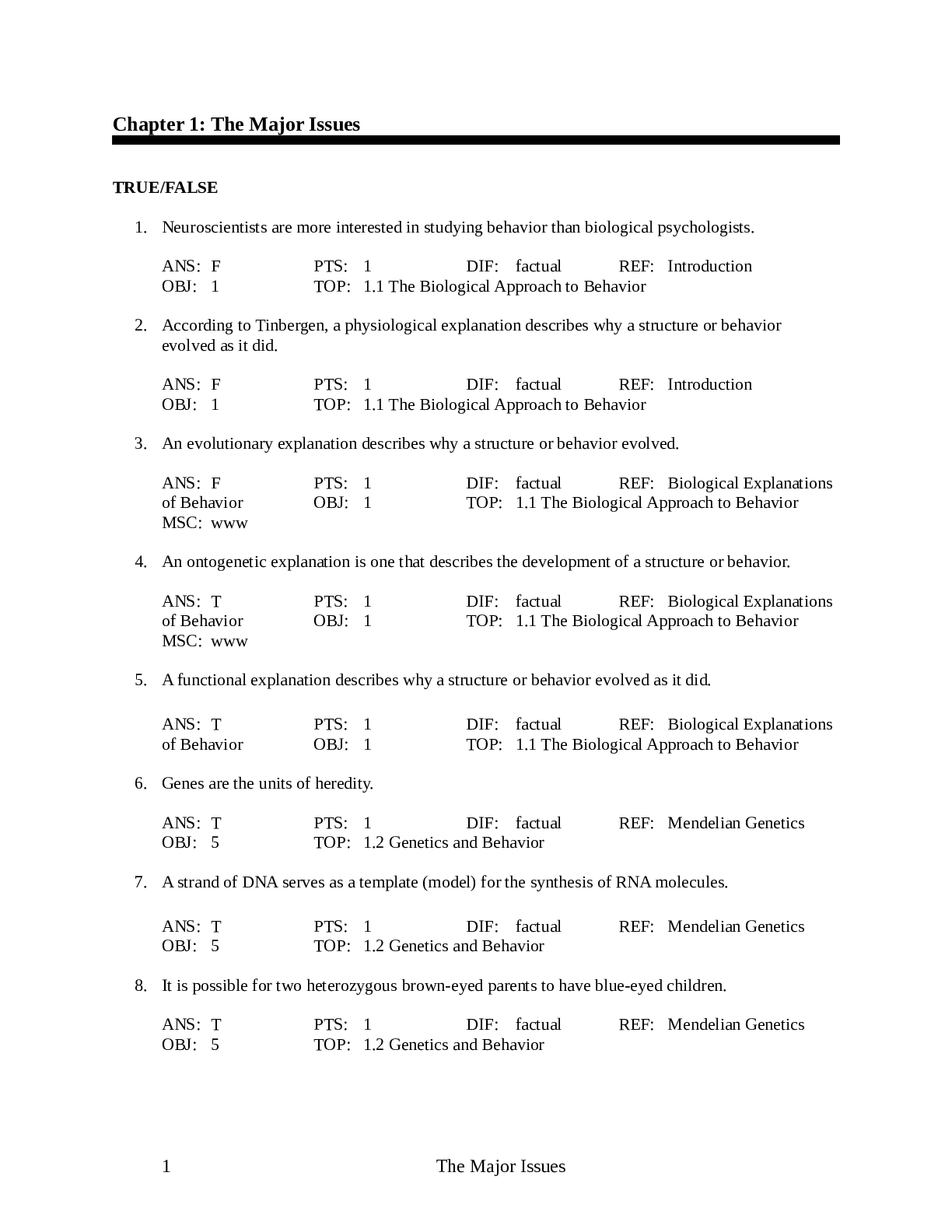
Buy this document to get the full access instantly
Instant Download Access after purchase
Add to cartInstant download
Reviews( 0 )
Document information
Connected school, study & course
About the document
Uploaded On
Sep 01, 2021
Number of pages
651
Written in
Additional information
This document has been written for:
Uploaded
Sep 01, 2021
Downloads
0
Views
37

